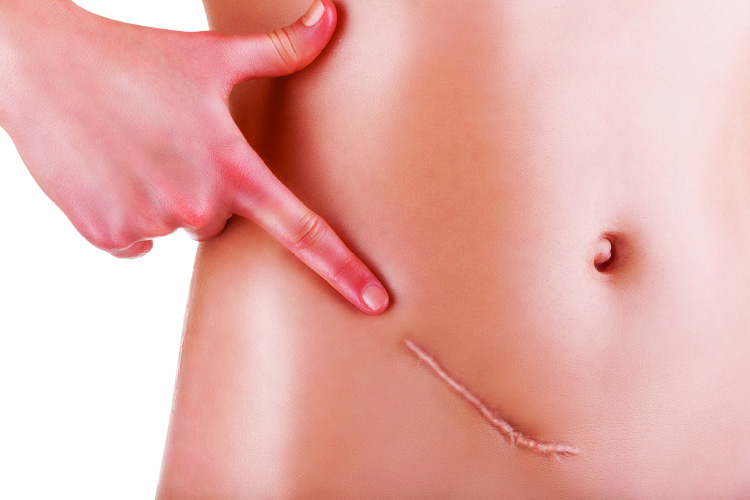When it comes to treating C-section scars, it’s best to let the wound heal fully and only then treat the appearance of the scar.
Here’s how to do it in two stages:
You have had a Caesarean delivery, and now that it’s over, you still have to think about what you are going to do with the C-section scar. Experienced moms and experts advise to treat the scar with gentle care and to do it in two phases.
Table of Contents
Phase One:
Let the Wound Heal
Right after your C-section, the initial wound and scar may look scary but like all scars, they will heal. Be assured that
the scar you are looking at now may not look like that after six months. For now, just concentrate on the wound
healing process.
- It takes about four to six weeks for a C-section incision to heal. During the C-section recovery process, discomfort and fatigue are common.
- Focus your attention on keeping the wound clean and address any signs of infection that may occur. Watch for a sensation of heat on the wound, any swelling, redness, or pus oozing from the wound. If any of these appear, see your doctor immediately. Preventing an infection is one of the best steps you can take to make your scar look good in the long run.
- Take it easy. Rest when possible. Try to keep everything that you and your baby might need within reach. For the first couple of weeks, avoid lifting anything heavier than your baby.
- Support your abdomen. Use good posture when you stand and walk. Hold your abdomen near the incision during sudden movements, such as coughing, sneezing or laughing.
- Take medication as needed. Your health care provider might recommend ibuprofen, acetaminophen (Tylenol, others) or other medications to relieve pain. Most pain relief medications are safe for breast-feeding women.
- Drink plenty of fluids. Drinking lots of fluids can help replace those lost during delivery and breast-feeding, as well as help prevent constipation. Remember to empty your bladder frequently to reduce the risk of urinary tract infections.
- Avoid stretching the scar. Even gentle stretches will be too much stress for your new scar to handle. The stretching will potentially tear the new collagen fibres that are forming to hold together the scar. It could end up widening the scar.
- After six weeks, check with your doctor if your wound has healed. When it has fully healed, you can proceed to phase two to deal with the appearance of the scar.
Phase TWO:
Treating the Scar
Compression, C-section scar massage and silicone therapy are three natural, non-surgical ways to minimize the C- section scar’s appearance.
- If you have an especially thick or sensitive scar you can try scar massage as well, but consult your healthcare provider first. Only begin C-section scar massage after full wound closure with no scab remaining.
- Massage the area by providing gentle fingertip pressure on the scar with or without your choice of oil or lotion. Make small circles and up/down strokes (about 1 cm of glide) along the incision and then reverse for a total of 2-3 minutes, 2-3 times per day. Spend more time on thick areas and move in a direction to place gentle tension on where you feel resistance. Remember: it should not be painful or cause any swelling or discomfort.
- If the scar is red and tender, use gently massage strokes around the scar but not on top of it. Once it has healed more and is not red and tender, you may begin more intensive massage. To do this, press into the scar from different directions. Locate the area where the movement feels restrictive. The restrictions are adhesions. As you gently stretch and move the tissue with rolling movements or stroking movements in all directions, you’ll feel the tissue make gains in overcoming the restrictions.
- When you massage the C-section scar, the best type of massage lotion to use could also be one that’s scientifically formulated to heal the scar. You can begin using a topical scar treatment once the sutures or staples are removed.
- Silicone therapy, another common C-section scar treatment, helps to minimize the appearance and scar size while reducing itching, burning and redness.
REMINDER…
Check your C-section incision for signs of infection. Contact your health care provider if:
- The incision is red, swollen or leaking discharge
- You have a fever higher than 100.4°F (38°C)
- There’s pain around your incision
DID YOU KNOW?
The four most important ingredients to get rid of scars are vitamin C, aloe vera, silicone, and licorice. Each of these will assist is accelerating skin renewal in various ways.
















